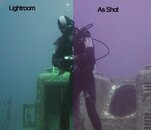Sorry for double-posting - I didn't notice the 2nd page.
I uploaded lots of recent photos here: Underwater in Eilat (2014)
If you are trying to judge quality, please look at "full-size" images (well, downsized to 2560 at larger dimension).
Note that the colors are improved in the last third - starting from DSC03545. First two thirds shot with FLD filter and WB measured off gray target; last third shot with FLB filter and WB measured off white target. It's Eilat (Israel), and the water appears to me as blue.
Everything is ISO400, exposure compensation -0.7, RAW processed with little noise reduction. Smooth areas are noisy, but the main problem was motion blur - I threw away too many photos. Still I think I won't like any more noise.
What I don't feel is that I need a lens any wider. The set of pictures comes from 6 dives; the lens was at 19mm for 5 of them and at 21mm (by accident) at the one with the sunk ship. 21mm is too narrow, but 18-19mm feels optimal to me.
I guess the urge for wider lens comes from using strobes and thus being able to illuminate only nearby region.
The available-light underwater technique has a different restriction - you can capture only a limited depth range with correct color, but it doesn't hurt to include more horizontally. If the shot spans significant range of depths, there is a clear color gradient. Another restriction: at large depths you cannot portray the color of the water - you make it "magentish" to keep your subject correctly colored.
I uploaded lots of recent photos here: Underwater in Eilat (2014)
If you are trying to judge quality, please look at "full-size" images (well, downsized to 2560 at larger dimension).
Note that the colors are improved in the last third - starting from DSC03545. First two thirds shot with FLD filter and WB measured off gray target; last third shot with FLB filter and WB measured off white target. It's Eilat (Israel), and the water appears to me as blue.
Everything is ISO400, exposure compensation -0.7, RAW processed with little noise reduction. Smooth areas are noisy, but the main problem was motion blur - I threw away too many photos. Still I think I won't like any more noise.
What I don't feel is that I need a lens any wider. The set of pictures comes from 6 dives; the lens was at 19mm for 5 of them and at 21mm (by accident) at the one with the sunk ship. 21mm is too narrow, but 18-19mm feels optimal to me.
I guess the urge for wider lens comes from using strobes and thus being able to illuminate only nearby region.
The available-light underwater technique has a different restriction - you can capture only a limited depth range with correct color, but it doesn't hurt to include more horizontally. If the shot spans significant range of depths, there is a clear color gradient. Another restriction: at large depths you cannot portray the color of the water - you make it "magentish" to keep your subject correctly colored.





